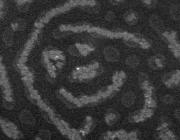Citation:
Eshdat, L. ; Ayalon, A. ; Beust, R. ; Shenhar, R. ; Rabinovitz, M. Up to six units of charge and twist-boat benzene moieties: Alkali metal reduction of phenyl-perisubstituted benzenes. Journal of the American Chemical Society 2000, 122, 12637-12645.
Date Published:
DEC 27Abstract:
Phenyl-perisubstituted benzenes, tetraphenylbenzene (1) and hexaphenylbenzene (2), were reduced by lithium and sodium metal in THF-d(8) under high vacuum. The reduction process and the nature of the reduction products were studied by NMR. Tetraphenylbenzene was reduced by both metals to yield the corresponding dianionic salt. It was found that the addition of extra charge into the system, restricted the free rotation of the four phenyl substituents about the sigma bond connecting them to the central ring (G(181)(double dagger) = 7.8 +/- 0.2 kcal mol(-1)). The reaction of the alkali metals with 2 yielded four diamagnetic species: the first three were assigned to the dianion, tetraanion, and the surprising hexaanion of 2. These species were calculated using density functional theory (DFT) and were found to have central benzene rings with an unusual twist-boat geometry. Computational and experimental evidences show that each phenyl ring and its attached carbon of the central ring behave like a benzyl anion. We therefore view the hexaanion of 2 as a cyclohexa(benzylanion). The fourth diamagnetic species was a product of a double-sided cyclization, which yielded the dianion of dihydro-9, 18-diphenylphenanthro[9,10-b]triphenylene (9,18-diphenyltetrabenz[a,c,h,j] anthracene dianion, 3(2-)). Reaction of the dianion with oxygen gave 3 in improved yields compared to literature preparations.See also: PhD papers (1997-2002)





